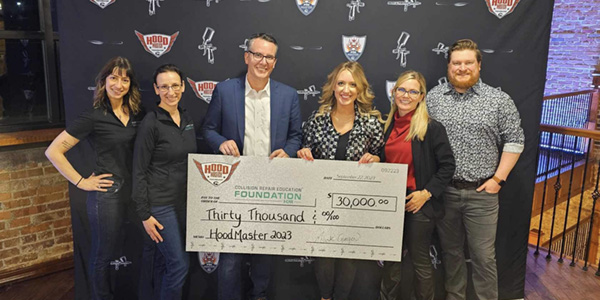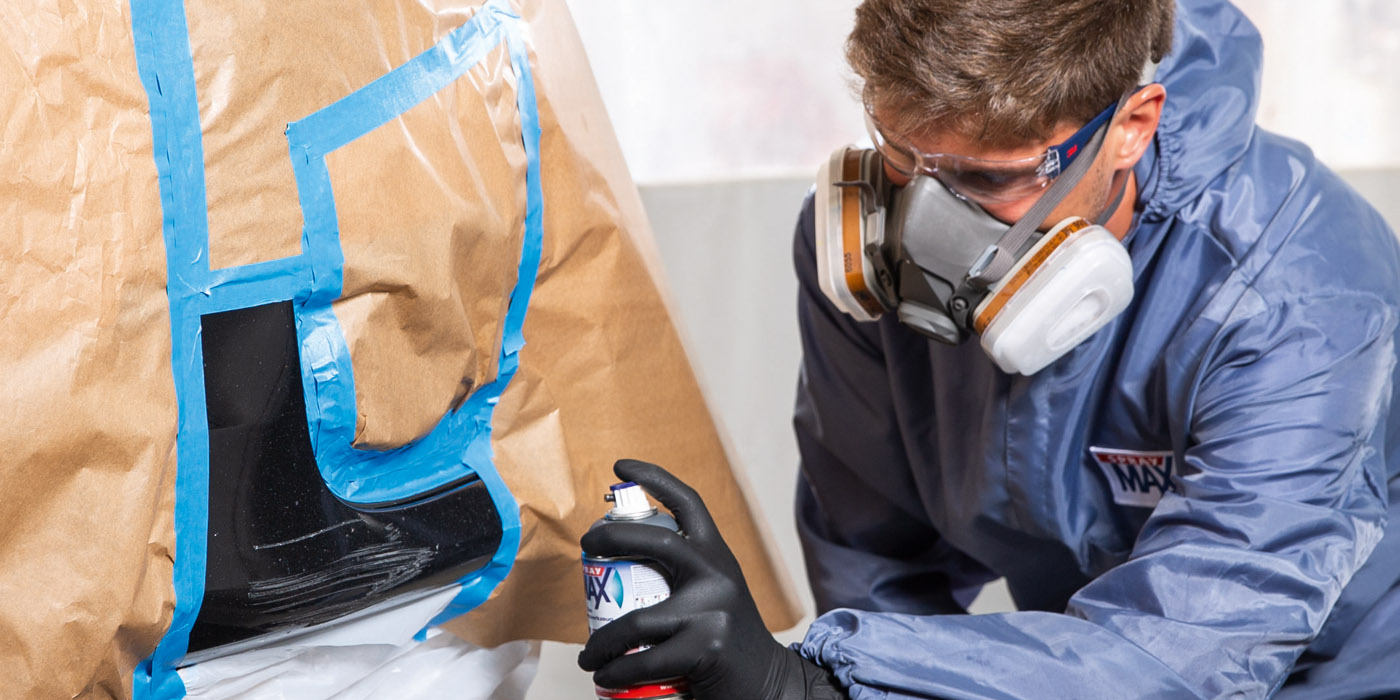Which way is the wind blowing auto paint these days?
I recently asked the major paint manufacturers what trends they saw on our near and far horizons. And because refinish paint technology tends to follow original equipment technology by several years and at a lower level of sophistication, they were able to make some pretty educated guesses.
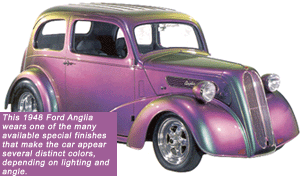
For example, I got an earful about ultraviolet (UV) cured finishes and their future value to the industry. Many people predict a complete industry sea change like isocyanate catalyzed urethanes caused in the 1980s. Time will tell. As for other trends, not surprisingly, there are still lots of color stylists trying to outdo their competition with ever-zippier reflective flakes and color effects. And last, but never least, the environment continues to benefit from lower auto paint emissions.
UV Curing: Ride the Wave
UV-cured paint resins offer several unique advantages. No. 1 is their speed. From wet spray to full cure in just two to five minutes, these resins offer a significant improvement over even the fastest heat-assisted urethanes.
How’s this possible?
UV waves come in several lengths just like infrared (IR) waves do. But rather than IR’s shortwave, medium wave or long wave descriptors, UV waves are lettered “A,” “B” and “C.” And the paint manufacturers construct their mix of paint resins to react to a certain UV wavelength.
Higher-energy waves increase the internal agitation that will crosslink and cure the resin quicker. Up to this point, most UV-paint research has been designed for very high-energy UV waves. In fact, industrial powder-coat applications use UV-B or UV-C waves, which are dangerous to human health. But this isn’t a problem since the typical UV-B or UV-C environment is mostly automated and robotic, with no people within the cure area. Such UV technology has made possible huge leaps in industrial coating durability, handling times and scratch resistance.
Then there’s UV-A waves, which are like those used in a tanning booth. UV-A lamps are the method of choice for refinish applications.
Can you get a tan from the UV light you bought to cure primer? Yes. Just be careful you don’t get burned. Automotive UV lamps use bulbs or ballasts that are tuned to emit enough electromagnetic energy to cause the “sites” within the paint resin to crosslink with other resin elements. The paint cures and becomes hard almost immediately when using a UV lamp. And these lamps are typically more powerful than the UV-A wave lamps at the tanning booth.
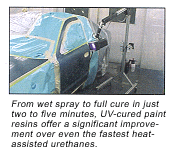
Several car manufacturers are using UV-cure resins on their current assembly line, and many more are interested in adopting UV cure for their repair lines. Since UV cure is so fast and so hard, the cured finish can be touched or further processed immediately. Imagine, OE-cure hardness in two minutes. There’s no die back and no transfer solvents to get trapped within the paint film.
The same properties make UV cure a natural for a super fast repair in a body shop, too. And most paint manufacturers are working hard on a full array of UV-cured products since many layers of the repair can be accelerated with UV lights. Primers, primer-surfacers, sealers and clears all dry faster using UV technology.
But I didn’t speak to any paint manufacturer who was contemplating a UV-cured refinish basecoat color system. Why not? Current basecoat systems are already very fast, and the few minutes of open time between coats is put to good use in blending and leveling the repair. Curing the multiple coats of base color would save little time overall and make inter-coat adhesion more difficult.
By the way, inter-coat adhesion between multi-layers of UV-cured products can be a problem. They dry so hard, so fast. It’s one of the issues the paint manufacturers will solve by mixing resins and photo initiators (the catalyst) to work with the exact wattage from a specific UV light. Done correctly, various layers of UV-cured material will adhere perfectly to other layers.
Along these same lines, many paint manufacturers proudly told me of the immediate surface hardness of the UV paints. And they are very scratch resistant and difficult to mar. The converse is that UV-cured paints tend to not be very flexible. One challenge that will take some time to solve is a UV-cured flexible bumper finish.
Another potential problem for UV-cured auto paints is the shadow areas. The UV-A light shines on the car’s surface like a flashlight beam, and only the area illuminated by the UV-light beam will cure. Any areas of the car under shadow won’t cure at all. This is a new problem for auto painters.
Many shops use an infrared heat light to speed the cure of 2K isocyanate paints. When using an IR heat light, areas of the car body also fall into shadows. For example, the area behind the door handle or the area under a spoiler doesn’t get the direct beam from the infrared bulb. Still, the metal of the panel in the shadow gets hot by convection. When the metal under the IR light’s beam gets hot, the area under the door handle also gets hot as the heat creeps across the metal panel.
With UV light, no such creep occurs. The beam of UV light must shine directly on the panel to cure the paint. Some OEMs solve this shadow problem by using a dual-cure system. A combination of high-energy UV waves and a chemical reaction spurred by external heat ensure the entire panel cures on their assembly lines. Shops, however, currently have to move the UV-A light beam until it touches all parts of the panel.
How will this UV technology work in your shop? For one, you’ll have to get better and more conscientious at using the light. Most shops let their infrared light languish in the corner because it’s too much trouble to wheel it across all the air hoses and floor grates around the shop. As you know, urethane paint will still eventually dry without the IR light; it just takes longer. But UV finishes won’t cure without application of the UV energy waves. You could take the car outside into the bright sunlight provided you have sunlight every day, a really clean parking lot and several extra hours per repair!
In practice, the UV systems and products are best on a maximum two- or three-panel repair area. If you have to move the light three or four times to reach all the painted areas, you don’t save much repair time. A four-panel repair would (currently) be faster with conventional heat-accelerated 2K urethanes in a heated booth.
On the positive side, UV cure has very low energy costs, gets OE-hard cure in seconds and can be five times faster than a heated urethane system. Scratch resistance is great, you can polish it immediately and you’ll avoid the multi-components and pot life issues of mixing urethanes. And it’s not even terribly expensive for all the time it saves. Sound like the next big thing? Lots of people think so.
One visionary even sees the day when you’ll have banks of UV lights inside your spraybooth. They’ll be covered or protected during spraying, but once painting is completed, the banks move on tracks to reach all parts of the car. This future system might even be UV-B, which means no one can be inside the booth. In fact, the lights in this future booth are connected to a motion sensor that shuts down the lights if it detects movement inside the booth. In less than five minutes under UV, the car is ready to be driven outside into the weather. Pretty cool.
What will you need to take advantage of this revolutionary technology? Training! All UV products and all UV lights are not the same. Changes in procedures, products, techniques and time lines will be necessary to take advantage of this great new technology. Everybody these days talks about speed systems and super-cure paints. They’re heeeere!! But you’ll have to be open to changing the way you do things in your shop.
I’m so old I remember when isocyanate hardeners first came out for acrylic enamel in 1970. Alkyd enamel shops couldn’t imagine switching. Who needs that new stuff anyway? From catalyzed urethanes to epoxy primers to waterborne color coats, new technology pushes the old out of the way. And UV cure is next. Get on board early, get the training and make the changes. Your reward will be to finish your paint work in 20 percent of the current time. There’s money in that.
Color Effects: Nothing Flaky Here
Effect pigments or reflectants can make even dull, square cars look interesting. From the original aluminum flake first added to auto paint in the 1930s to today’s five-layer chromatic pearls, the object is to get consumers to buy the vehicle.
Today’s consumers have an affinity for high technology, and the high-tech, precision metal-look sells very well to consumers of kitchen appliances, computers and cars. Hence, aluminum silver is the No. 1 car color in luxury cars, full size and intermediate cars, light trucks, SUVs and minivans. The only category of vehicle not lead by silver is sports and compact cars. It’s second to white for those vehicles.
Silver last led the color choice chart in 1979. And according to the DuPont automotive color popularity survey, silver has displaced the most popular color of the 1990s green. In 2002, the only color that was really a color among the top choices was blue. The other top finishes silver, white, black, gray and beige aren’t really chromatic colors. Predictions are that silver will continue to be popular and that blue-toned silver will gain ground.
All this silver reflectance flake still causes problems for both OE and refinish. Aluminum flake is especially spray sensitive. As you well know, you can make almost any metallic color lighter or darker by how you spray the job.
Colors with flake in them look darker when the film is sprayed wet at low air pressure because the flake settles down to the bottom of the paint film. And metallic colors look lighter when the paint is sprayed dry at high air pressure because little pigment is between your eye and the flake at the top of the paint film.
All this talk about silver leads us to a fact that many painters ignore: As much as 45 percent of all refinish paint repair requires a variant formula. Spraying test panels each time before painting anything on the customer’s vehicle is still the fastest way to success. Silver colors especially.
But enough about silver. There are the special reflectants that offer still more color effects. Whether a five-layer pearl or the new Xirallic flakes, the car can appear several distinct colors from different angles.
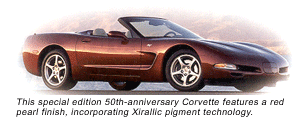
One paint manufacturer, however, predicts that consumers will begin to tire of these super chromatic flake effects not only because they’re expensive to purchase and repair, but they often look muddy or dirty under some light sources.
Regardless, color stylists are hard at work on the next nifty color effect. We have three-stage pearls, two-stage candies (tinted clear), three-stage metallic candies (silver base, tinted clear, clear) and many different types of reflectant flakes all designed to make the car color so attractive and unusual that consumers will snap them up.
One new trend is toward colored metallic flakes. These reflectants will offer a different look than using aluminum flake as a base and putting tinted clear over it. Most paint companies also predict that more holographic flakes will arise using different layers of coatings, different shapes (round mica) and different flake sizes. As many of you have discovered, repairing some of the most chromatic paints is pretty easy. Unlike silver flake which must match the surrounding panels exactly for texture and value multi-chroma flakes are easier to blend since the surrounding panels give off many colors.
Lower Emissions: Taking Care of Mother Earth
Around the world, the paint companies are hard at work on paints that are better for the environment. As you know, the current National Rule calls for refinish paint systems with a maximum 3.5 pounds of volatile organic compounds (VOC) per gallon. Southern California shops under Rule 1151 must use products with 2.1 pounds of VOC. And several manufacturers spoke to me about user-friendly systems that are as low as 1.9 pounds VOC.
Imagine, auto paints so high in solids that 85 percent of their contents is resin solids and only 15 percent is solvents. They’re good for the air quality everywhere, have nice, easy-to-use low viscosity and are faster because one coat can reach film build requirements.
We should all send thank you notes to our paint brands laboratories. Those clever paint chemists have successfully done what seemed impossible when the EPA first wanted to regulate our business. Remember how GM in all those rust-belt factories painted every car with acrylic lacquer? And so did all the body shops that repaired them. Lacquer paint, which had nine pounds of solvent and one pound of solids in every gallon.
The chemists have not only cleaned up the air across the country from both OE and refinish emissions, they’ve made auto paints that are better in every respect. Paintless dent repair was impossible till a few years ago. You could always massage the metal smooth it was the paint that would crack off. Clears used to be yellow because of the UV screeners. UV screeners prevent the sun’s UV rays from breaking apart the clear resin prematurely. Now, every paint company has a low-solvent water-white (perfectly clear) clearcoat.
All of them are pretty good tricks. Thank the next paint chemist you see.
Waterbase color systems are also ready for trial in your shop today. They’re obviously good for the environment, and most body shops presently using them promote that fact loudly. They also have several other advantages in color match and clarity that appeal to some shops. But changes in techniques are a must. Instead of IR or UV lights, waterbased paints need lots of moving air. Banks of compressed air venturi cones pass huge amounts of air over the painted surface, and they must be moved around like the IR and UV lights to cover all areas of the panel.
Several other paint trends have environmental impact, too. Direct-to-metal primers skip the etching step and the resultant solvent emissions, in addition to being one step faster. Small-area repair systems use less solvent for both repair and clean up. Bear in mind that any repair-within-panel paint work has a smaller margin for error as well you can’t blend your mismatch over very much area.
Speed systems and super-cure speeds also are good for the environment because they limit the open time available for emission. Paints get better and so does the air quality. That’s a win.
Ready or Not …
Here comes the new technology. The new Ford concept car has a UV-cured clearcoat, and the new Rolls Royce has waterbase color. As for tomorrow, your paint manufacturer is ready to unveil something that will make your head spin. Try it. I’ll bet it’s faster and better.
Paint Trends: What’s Hot and What’s Not
Writer Mark Clark, owner of Professional PBE Systems in Waterloo, Iowa, is a well-known industry speaker and consultant. He’s been a contributing editor to BodyShop Business since 1988.










